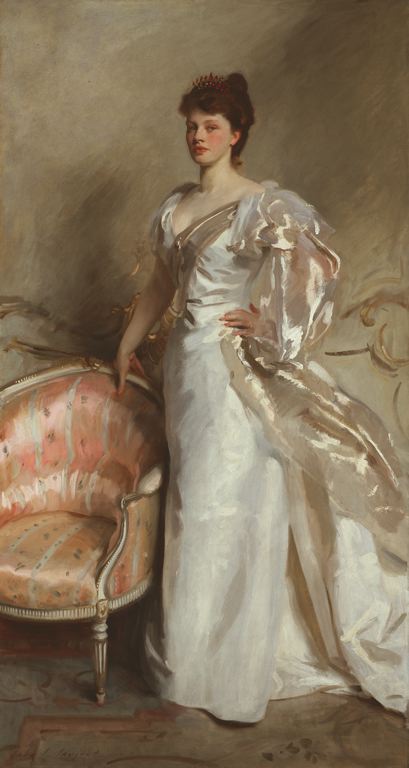
Largely adopting the same tone of shocked superiority, both Gizmodo and Boing Boing have featured the following picture of a Victorian/Edwardian-era prosthetic arm:
A century or so is not so long even in the scheme of human history, and in that short space of time there have surely been huge changes in design ability and sensibility across a wide range of technologies, with fashion and capacity alike playing roles. Yet while we certainly can understand the material constraints that would have led to creating a prosthesis along these lines, we are apparently still left with a sense of “what were they thinking”?
Now consider the following portraits from the same era by the great John Singer Sargent. The first, from 1897, is of Mrs. George Swinton:
Nobody may dress like this anymore, but the sense of bored or slightly impatient, self-satisfied superiority in the language of her body and her face is instantly recognizable. Or consider this later portrait (1906) of Maud Coats, no less than the Duchess of Wellington:
It’s reasonably obvious to me, anyway, that she must have been quite a hoot: the ironic but not unfriendly smile on her lips and in her eyes, the determined conformation of her left hand and arm. She can barely bring herself to grasp the clichéd white rose she has been given.
We might not all see exactly the same thing when we look at Singer’s portraits, but they are not oddly mysterious in the way that the prosthetic arm is. Which suggests to me one of the great problems hidden within transhumanist aspirations: If our minds and bodies are to be increasingly technological artifacts, then should we not expect that transhumans will have as little understanding for each other, and for their own pasts — both collective and personal — as we have for that arm? Human solidarity can extend back for hundreds, even thousands of years, based on the continuities of human nature; but in a fast-paced world hurtling towards the Singularity, a world in which the fads of fashion and design seek to replace the unvarying aspects of human nature, it seems likely that transhumans will much more regularly find themselves saying, “What were we thinking?”

Futurisms
September 8, 2010



I don't find the arm so hard to understand. I see two sides of it.
One side is the ghastly, cold, riveted blue steel, intended to imitate human flesh but instead expressing, embodying and calling our attention to the harsh reality of its loss.
The other side is the person who wore it, who had lost an arm, and had to make the best of life with an arm missing. This prosthesis may have been ugly and awkward, but it must have eased the suffering somehow.
Then there is, in between, the cuff of musty, dried leather, itself once part of a living animal, and perhaps even more evocative of mortality than the "sinister" bony fingers…
So anyway, does someone think that today's modern technology has produced a better prosthetic arm?
Better, perhaps, for ameliorating the lives of survivors of accidents, disease or violence. Better in that sense. But no less ghastly, no less mechanical, nor any more alive than this "primitive" artifact.
As the wearers of such prostheses must surely know and feel.
Behold the mechanical man, that some would call child of humanity.
Behold the attempt to substitute technology for flesh, to recover the loss, let alone "enhance" the body.
What we see here is the difference.
Nice bringing in John Singer Sargent and the way human– very familiar human– characters come poking out of the artificial poses.
Yet there is no fixed set of costumes and props that would make them appear natural. We are unnatural without our choice of artifice. Unseat a man from his horse or his Harley and you have an age-old fight on your hands.
What are you thinking, that we would give it all up just when we're starting to (to borrow a phrase) get good at it?
Thanks for your comment. In this post I was thinking less about giving anything up and more about how transhumanism has little ground on which to claim we are “getting good” at anything in particular. The next big thing will always make the previous big thing look primitive and awkward. I suppose it might be said, then, that we are becoming ever better at being dissatisfied, or even that dissatisfaction is the human thing that will continue to shine through artifice, the fundamental thing that will still apply as time goes by. Happy thought.